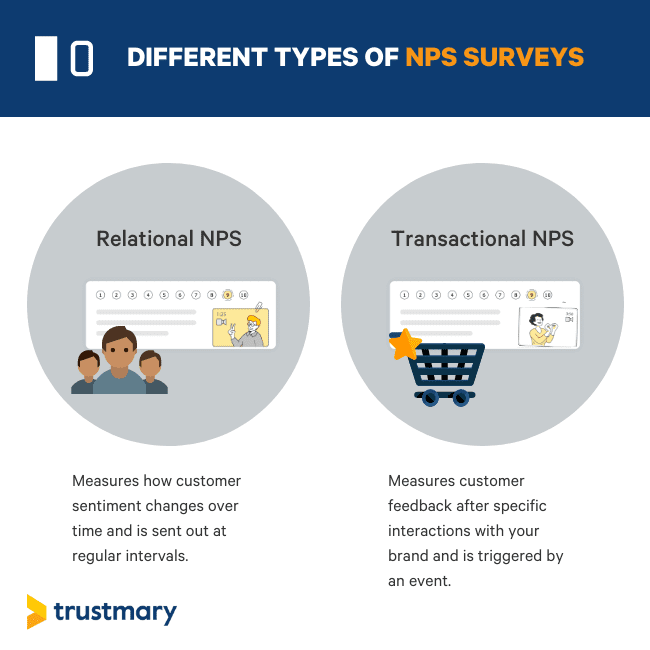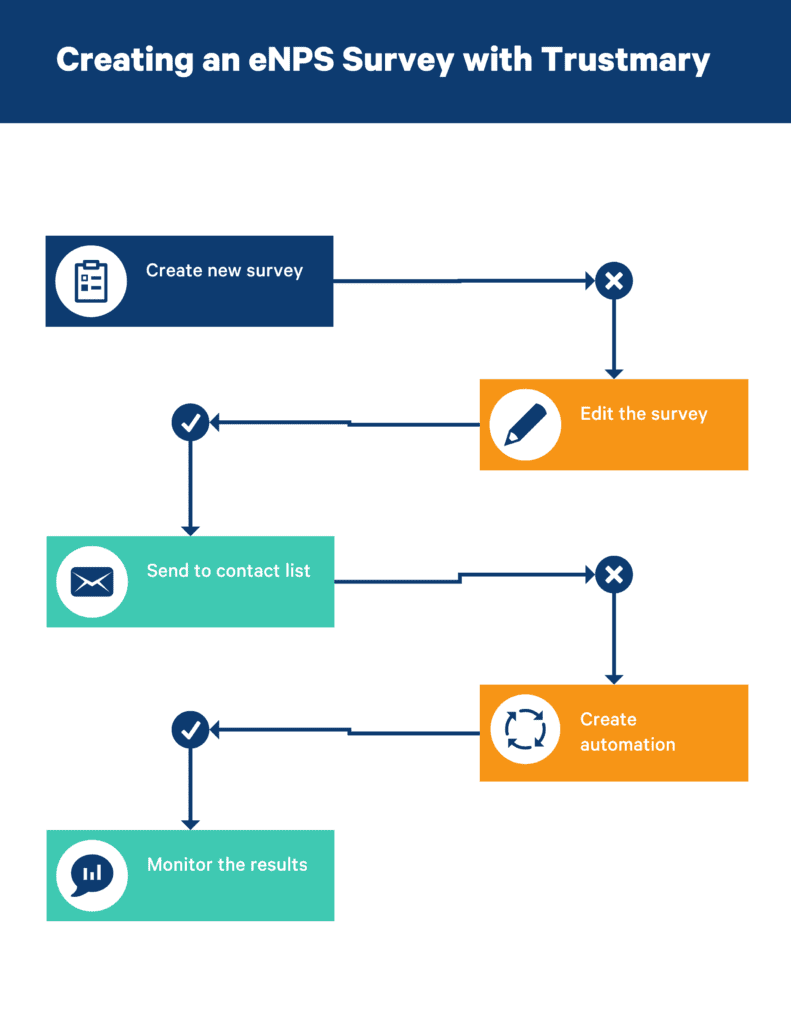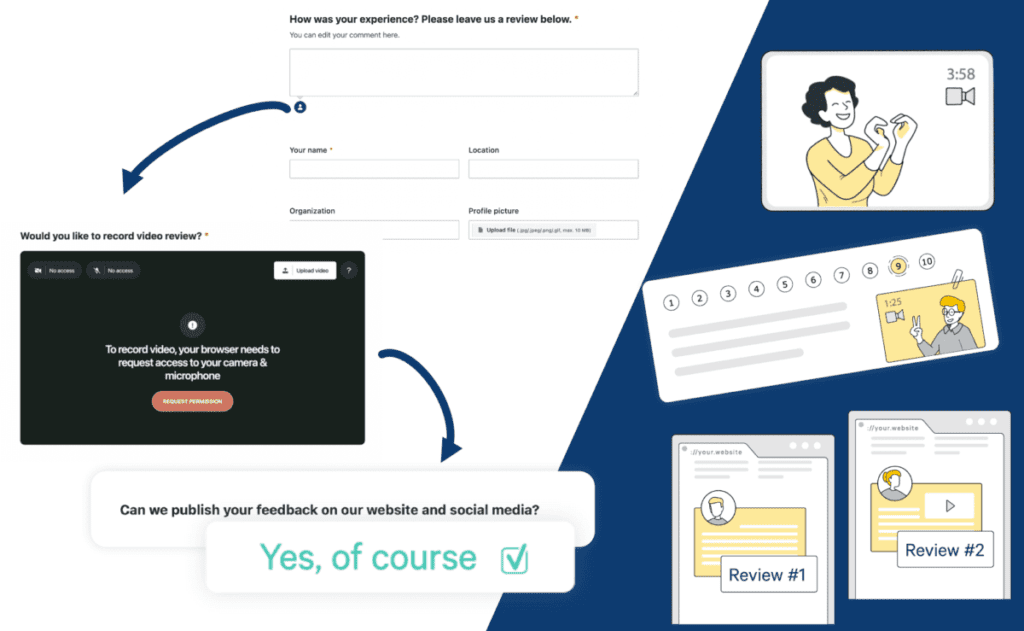Net Promoter Score Question Templates to Copy


You probably know the one Net Promoter Score question that you see everywhere.
But did you know that you can modify the NPS question to various contexts?
This article discusses
- The basics of NPS
- Introduces some variations of the NPS question
- The follow-up NPS survey questions
Back to the Basics of Net Promoter Score
Before I move on to the templates, let’s recap what Net Promoter Score (NPS) means.
What Is NPS Used for?
Net Promoter Score is a widely used customer satisfaction and customer loyalty metric.
But unlike other customer satisfaction metrics, it does not ask customers about their satisfaction, per se. It actually captures the willingness to recommend.
Many businesses use it as a method of customer feedback because it is easy to use, interpret, track, and benchmark.
Another benefit of NPS is its brevity. It consists of a rating that can be completed in just one click.
An extra question is often included for additional feedback.
How Does the NPS Survey Work?
An NPS survey starts with the question: How likely are you to recommend this company to a friend or colleague?
This is a rating question that is answered on a scale from 0-10.
Based on the answer, your customers are divided into three groups:
| Score | Category | Description |
| 0-6 | Detractor | These are unhappy customers. They are likely to churn or even spread negative word-of-mouth if you don’t react fast and fix the issues. |
| 7-8 | Passive | Passives are customers who are somewhat happy with their experience, but not loyal. They are likely to switch to another brand or company if there is a more attractive offer. |
| 9-10 | Promoter | Promoters are happy and loyal customers who are not only going to stay with you but also recommend your business to others. |
After the initial rating question, you can continue with an open feedback question to unravel the reasons behind the score.
But more about that later.
How to Calculate NPS?
Calculating NPS follows this formula:
Percentage of NPS Promoters – Percentage of Detractors = your NPS score
Passives are not taken into account in this calculation. What matters is the percentage of your happiest and most unhappy customers.
In the end, you get a number between -100 and 100, which is the final Net Promoter Score.
You can calculate your NPS score using pen and paper, or you could opt for an interactive calculator. However, the easiest option is NPS software like Trustmary.
For more information, see our separate blog post about NPS calculation.
What Can I Learn from NPS?
It’s no wonder that NPS is called the one number you have to grow. It can tell you many things that are crucial for your business.
Customers who are willing to recommend a business to others are valuable.
If you have one loyal customer who recommends you to their friends constantly, you have a chance to get lots of new customers through this one person. It’s better than having just “somewhat happy” customers who might stay with you for a while.
The conclusion?
The number of Promoters predicts business growth. NPS helps you identify your Promoters.
Another thing that NPS can do for you is to identify the customers who are likely to churn or even speak negatively of you.
After all, it’s quite a strong statement to say that one wouldn’t recommend a business.
Furthermore, the Net Promoter Score makes it possible to track your performance and see if you are on the right path to customer satisfaction and create customer satisfaction survey templates.
As the result is presented with one simple number, it’s easy to benchmark your performance against yourself and others.
Net Promoter Score Question: The Most Used Variation
The most used version, or the “basic” NPS question is:
How likely are you to recommend [this company] to a friend or colleague?
It’s simple and takes into account many different target groups.
The universal nature of the question can be a blessing and a curse.
- What if the customer likes your products, but the company itself doesn’t evoke any emotions?
- What if the customer would recommend you to a friend, but not a colleague?
When there are different ways to interpret the question, people might be answering it from various perspectives.
If you want to learn about exact situations and perspectives, you want to use a more specific NPS question.
NPS Questions to Try
In this section, I'll go over different types of NPS questions.
When calculating NPS, you must figure out what you want to know, and formulate the question accordingly.
If you are asking multiple questions, make sure you keep the results separate from each other.
You don’t want to mix up the relationship NPS with product NPS and analyze them as one entity.
Relationship NPS
Relationship NPS measures the overall customer experience, especially in long-term customer relationships.

When you conduct regular NPS surveys to your whole customer base, you learn about
- the overall progression of customer satisfaction.
- the progression of an individual customer relationship.
When choosing the right relationship NPS question, ensure you target the right perspective and align it with your business model.
If you are a B2B company, align your word choices with this fact. Use “colleague” instead of “friend”. The opposite can be used for B2C contexts.
Relationship NPS Question Variations
Try these variations of the question:
- How likely are you to recommend our company to a colleague?
- How likely are you to recommend our services to a friend?
- How likely are you to recommend the collaboration we have been doing?
- How likely are you to recommend our company as a partner?
It’s recommended to conduct an NPS survey once a quarter to keep track of customer satisfaction and react to possible negative changes.
Transactional NPS
Transactional NPS can be used to gain insight into specific stages and touchpoints of the customer journey.
Transactional NPS Question Variations
Be as specific as possible, and don’t forget the right timing and channel to distribute your NPS survey.
- Based on your latest purchase, how likely are you to recommend our products to a friend or colleague?
- Based on your experience today, how likely are you to recommend our service to a friend or colleague?
- Based on your interaction with our customer support, how likely are you to recommend our business to a friend or colleague?
- How likely are you to recommend a support meeting with Mary to a colleague?
Product NPS
Sometimes you might conduct a product survey to find out how you could develop your product.
It’s a good idea to start off with an NPS question. It can act as an overall satisfaction metric, or even compare two different products with each other.
Product NPS Question Variations
- How likely are you to recommend this product to a friend or colleague?
- How likely are you to recommend this product to your friend over a [competing product]?
- Based on the durability of the product, how likely are you to recommend it?
- Based on the usability of this product, how likely are you to recommend it?
You might want to conduct a longer product survey with multiple NPS questions or shoot individual questions to different customers to gain a snapshot of your customers’ opinions.
Employee NPS
Lastly, let’s discuss the Employee Net Promoter Score, the eNPS.

It works the same way as regular customer NPS surveys, but it is aimed at employees.
Using eNPS can help you with employee retention, and lets you know how your employees are feeling about their job.
Employee NPS Question Variations
Here are some examples of eNPS questions:
- How likely are you to recommend this company as a workplace?
- How likely are you to recommend your managers to other employees?
- How likely are you to recommend the atmosphere of the organization to others?
- How likely is it that you would recommend this company as a workplace to someone who is looking for professional development?
- How likely is it that you would recommend this company to someone who is looking for a well-compensated position?
These questions not only reveal how satisfied your employees are with the company but also what characteristics they connect with your company.
If they would not recommend your company to someone who is looking for professional development, it’s a clear sign that they do not view the company as a place where one could develop professionally.
When you learn these things, you can start investigating why that is, and improve NPS and the whole organization.
Net Promoter Score Question Follow-up Templates
Asking a follow-up question is highly recommended.
It adds qualitative feedback to the mix and lets you see the “why” behind the “how likely”.
It’s the key to developing your business.
Most often, the follow-up question is an open-ended question, where the respondents can describe their thoughts in their own words.
Don’t forget to thank your customers for leaving feedback!
1. Simple Follow-Up Question
If you want to get results with less effort, you can use one straightforward question for all respondees:
- What is the primary reason for your score?
- Why did you choose this score?
- Could you elaborate on why you chose this score?
- What makes you choose this score?
These examples fit all answers but lack personalization and empathy.
2. Personalized Follow-Up Questions
If you want to add more personalization and conversation to your NPS survey, you can use conditional logic and configure different follow-up questions for different NPS scores.
For Detractors
- I’m sorry to hear your experience was not the best today! Would you like to tell me more about why you are unhappy?
- Oh no! What could we have done better?
- Sorry to hear that! Is there a specific reason for your score?
You could even add an additional customer feedback question where you offer to fix the problem in a separate meeting:
- We would like to make this up to you. Please leave your email address or phone number so we can be in touch with you.
- If you want to talk more about your experience today, leave your email address so that our customer service can contact you.
- We are sure we can find a fix for the situation. Please click the link below to chat with a customer service representative.
Remember: it’s a good sign if a customer gives you constructive criticism and goes through the trouble of letting you know what they feel.
You still have a chance to fix things and turn detractors into happy customers.
After all, they could as easily just churn without saying a word.
For Passives
In case of passive customers, you want to know what prevents them from giving a higher score.
- Could you tell more about what makes you choose this score?
- What could we do better next time?
- What would have earned us a higher score?
- Thank you for the feedback! Is there anything we could have done differently?
For Promoters
Promoters can tell you what your strengths are from the perspective of the customer.
As they are extremely happy, they might not have too much criticism, but you could ask for constructive feedback as well.
- Great to hear you are enjoying our products! What did you especially like about them?
- We love to hear that you are happy with our collaboration! Is there something you especially like about it?
- Good to hear you are happy! Is there anything we could do even better next time?
3. NPS Survey with Testimonial Request
The whole idea of NPS is to ask if your customers (or employees) would be willing to recommend your business.
Why not let them?
Keep the NPS question and the follow-up question, and add a third phase to your NPS survey: a testimonial request.
Testimonials are a great way to showcase your happy customers and convince new customers to trust you.
When you use an NPS survey and testimonial request together, you can identify the happy customers and ask for permission to use their feedback publicly.
Here’s how Trustmary does it:

You can decide whether you ask for written or video reviews.
Why does this work?
- When a customer has established a behavior (willingness to recommend), they are likely to follow through with it in the moment.
- When you collect public comments only from happy customers, you don’t have to go through all feedback to decide which comments you want to publish. You can keep the feedback and the testimonials in separate files.
- When you explicitly ask for permission to publish the feedback, you won’t run into problems later.
You Get What You Ask
It makes a difference which NPS question you choose to ask.
It’s one thing to recommend a product, and another to recommend a company. You might recommend something to a friend, but not to a colleague.
Even though it sounds trivial, the smallest details can influence how your customers reply to your NPS surveys.
If the question isn’t aligned with what you want to learn, you risk misinterpreting the results.
The second thing to consider is the follow-up question.
An open-ended question offers you more context for the NPS survey results.
Personalized questions can get you more replies as compared to generic questions.
On top of the follow-up question, you might want to do the following:
- Ask for detractor’s contact information to reach out to them.
- Ask for public testimonials from your promoters.
When you utilize NPS surveys, you can make predictions about your business growth and track your progress.
Learning how to present NPS results can also be beneficial!
Further Reading
FAQ
What is a Net Promoter Score?
Net Promoter Score (NPS) is a widely used metric for customer satisfaction and customer loyalty. It reveals who are the best advocates for your business, and who are so unhappy with your business that they might spread negative word of mouth.
How to do Net Promoter Score calculation?
NPS is calculated by the percentage of detractors from the percentage of promoters. Detractors are unhappy customers who give you a score 6 or lower out of 10. Promoters are the satisfied and loyal customers who give you a score of 9 or 10.
What is the Net Promoter Score question?
The most popular NPS question is “How likely are you to recommend [company/product/service] to a friend or colleague?”. However, you can personalize the question to fit many different contexts. The main point is to find out which customers are willing to recommend your business.
How to use the Net Promoter system?
Using NPS is best done by implementing NPS software like Trustmary. It collects the customer feedback and turns positive feedback into customer reviews.